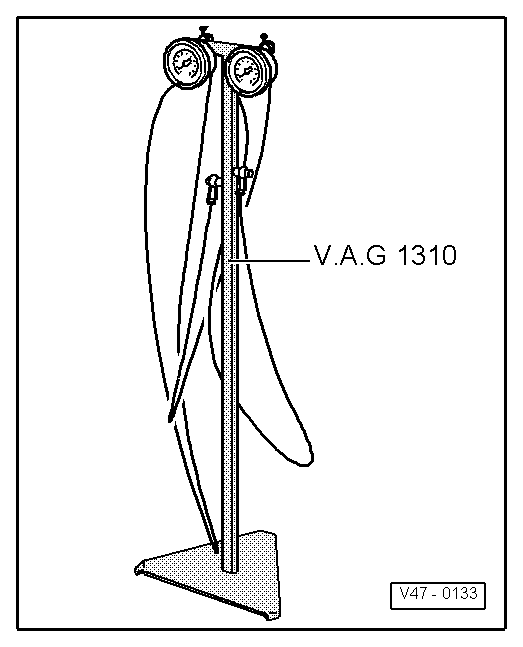| t
| Tester for brake pressure regulator -V.A.G 1310A- |
| Ensure adequate servo assistance is available for this test. |
| –
| Vehicle raised on a two-column lifting platform. |
| Make sure that the brake system (master cylinder, brake hoses, brake lines and brake calipers) works properly and is free of leaks. |
| –
| Connect tester for brake pressure regulator -V.A.G 1310A-. |
| Fault-finding procedure if pads are worn on one side of the vehicle: |
| –
| Remove bleeder screw at one of the front brake calipers. Connect pressure gauge (tester for brake pressure regulator -V.A.G 1310A-). |
| Simulate brake applications at various pressures up to approx. 100 bar. |
| t
| Operate brake pedal slowly at various pressures. |
| t
| Operate brake pedal rapidly at various pressures. |
| –
| Firmly depress brake pedal once as far as it will go. |
| If the wheel is difficult to turn and there is no residual pressure in the system: |
| –
| The pad may be sticking in the guide rail in the caliper, or the caliper may be dirty. |
| –
| The piston may be seized or sticking in the caliper. |
| If the wheel is difficult to turn and there is residual pressure in the system: |
| –
| The pedal mechanism may be sticking, or foreign bodies in pedal mechanism. |
| –
| If it is possible to pull back the brake pedal slightly so that the brake pressure drops to zero, the brake servo must be renewed, or the pedal mechanism is sticking. |
| Checking brake master cylinder |
| –
| Connect tester for brake pressure regulator -V.A.G 1310A- and build up a pressure of 5 - 10 bar without vacuum assistance. Renew brake master cylinder if pedal yields continuously under this pressure. |
|
|

|

